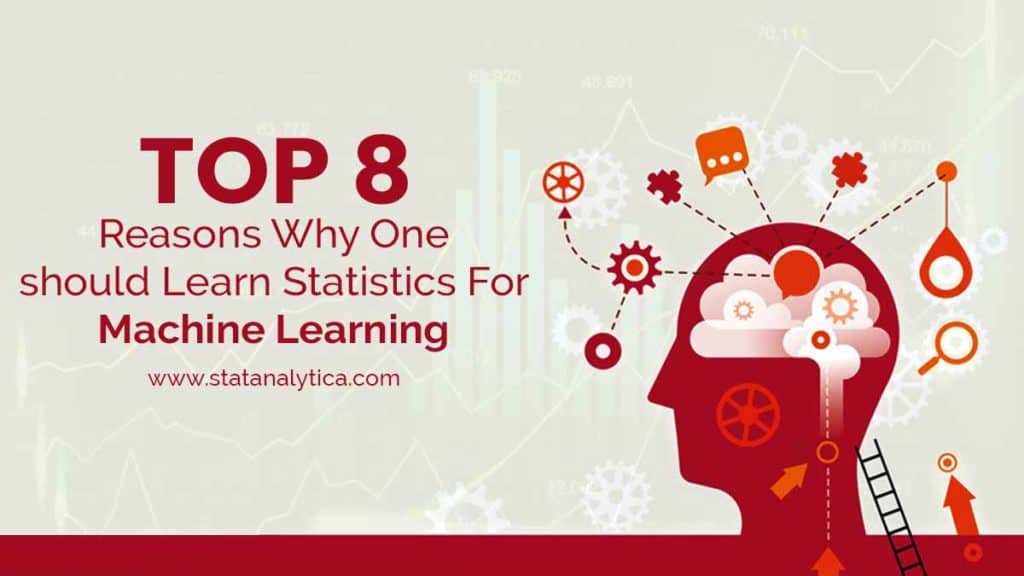Statistics is one of the mathematical branches. It is universally agreed that knowledge of statistics is mandatory for machine learning. Statistics has a wide range of studies that involve findings and theories, notations, and the nuts-and-bolts tools that are considered by machine learning practitioners. Therefore, it becomes necessary to have a solid understanding of statistics for machine learning. This blog will provide you with the basic concept of machine learning. Let’s check the details on it.
What are statistics and machine learning?
Table of Contents
Machine learning is one of the subfields of artificial intelligence and computer science. It deals with system building that is learned from given data rather than explicitly coded instructions.
Statistics is a subfield of mathematics that calculates largely ranged data and then represents it understandably.
Statistics and machine learning are two interlinked fields of study. Therefore, statisticians usually refer to machine learning as “statistical learning” or “applied statistics” instead of the centric name of the computer science subject. Machine learning might be a universal representation for beginners, predicting that the students have some knowledge of statistics.
How much statistics is needed for machine learning?
This is actually a good question that many people might have pondered while approaching ML tasks: How Much Statistics is Needed for Machine Learning?
Because the complexity of the problems that machine learning can solve differs, so does the quantity of statistics necessary, as I described above. So, if you are concerned with simple models such as linear regression or mere classification, the basics should suffice for you. Nevertheless, when you are using even more complicated models like neural networks or deep learning concepts, a basic understanding of statistics will prove critical.
Here are some key areas of statistics that are important for machine learning:
Descriptive Statistics: Arithmetical mean, median, mode, variability as variance and standard deviation are required basics to study the distribution and behavior of data values.
Probability Theory: Probability mass functions and less familiar differences should also be described in the conditional probability to probability distributions since many machine learning algorithms rely on these concepts.
Hypothesis Testing: Such things as p-values, alpha levels and t-tests assist in model evaluation and checking assumptions.
Bayesian Statistics: Naive Bayes and Bayesian networks are some of the methods that have grown to depend on this branch in the recent past.
Statistical Inference: Estimation and testing of a population from sample data using confidence intervals and the central limit theorem play a huge role in prediction.
As a rule, if you start choosing machine learning algorithms, you should have basic knowledge of descriptive statistics and probability theory. In further classes, you will study subjects such as statistical inference and Bayesian procedures.
See Also: How to Use Different Types of Statistics Test
Probability and Statistics for Machine Learning
Probability and statistics were earlier stated as constituting the heart of machine learning, which aims to explain uncertainty and build models around it.
Let’s break down how these two fields contribute to machine learning:
Descriptive Statistics: Let me declare that, in fact, machine learning starts with data mining and data preprocessing. In particular, descriptive statistics are beneficial to use prior to running the algorithms, as these help to describe patterns of the data and the nature of the correlation of different parameters. Mean, variance and correlation are very important functions that are used in data preprocessing and feature extraction.
Probability Theory: It is not a secret that many of the studied machine learning algorithms are based on the principles of probability theory. For instance, Naïve Bayes involves a make-up of probabilities according to Bayes’ Theorem, Hidden Markov Models on joint probabilities.
Probability Distributions: Some important distributions are normal distribution (Gaussian), binomial distribution, and Poisson distribution. Practitioners in this field of machine learning keep certain things in mind. These distribution assumptions help in making the choices between the models and the evaluation methods.
Statistical Inference: In machine learning, you frequently require making a prediction or estimating the characteristics of a population by using some of the features of the sample. Descriptive techniques such as confidence intervals and inference techniques like hypothesis testing (e.g., t-tests, ANOVA) are utilized in assessing models, comparing algorithms and verifying assumptions.
Bayesian Statistics: Bayesian methods are becoming more popular in machine learning. In particular, Bayesian inference enables you to feed new data into the probability assessment of a hypothesis. The government, earlier known as a Bayesian network, and Gaussian processes are two examples of algorithms that use statistics to make decisions under conditions of uncertainty.
See also Top 7 Types of Statistics Graphs for Data Representation
The Role of Statistics in Machine Learning
Statistics plays a pivotal role in machine learning in the following ways:
Data Preprocessing: For any machine learning model it is highly recommended to proceed with the data pre-processing step. Statistics gives techniques concerning missing values, outliers, and scales of measurement such as normalization or standardization. These make sure that the data is ready for modeling to be done.
Model Selection and Evaluation: Statistics is useful in making model selections as it offers indications for measurement. Validation procedures, such as k-fold cross-validation, bootstrap and hypothesis testing, give an estimate of how the model performs when new data is fed to it. All basic evaluation measures, such as accuracy, precision, recall, F1-score and ROC curves, can be traced back to statistical measures.
Understanding Model Uncertainty: In fact, numerous machine learning frameworks, particularly probabilistic models, predict not only the outcome but also the likelihood of such an outcome. Probability gives substance to this uncertainty through the mathematics of statistics including confidence and reliability coefficients concerning the model. Specifications such as confidence intervals and p-values are used to define how certain we can be on model predictions.
Feature Selection: Methods like correlation analysis, mutual information, and principal component analysis (PCA) are used in the selection and feature space dimensionality process. These techniques can help identify important features in the data that improve the model, and in this sense, the laptop greatly helped.
Improving Model Performance: Some of the mathematical tools used in presenting and analyzing ML results are also used to improve and adjust such models. For example, the formal definition of variance and bias can be useful when the models are being adjusted to avoid undershooting or overshooting. In addition, statistics such as Lasso and Ridge employ the concept of penalization on extremely complex models.
Also Read: Statistics Inference: Why, When And How We Use it?
How to Learn Statistics for Machine Learning
Taking lessons in statistics for machine learning can be formidable sometimes, but the best way to approach it is to ease into it by creating a statistical learning roadmap that directs someone to the advanced level.
Here’s a step-by-step guide to help you get started:
Start with the Basics: Starting with the harvesting of knowledge, start with the learning of descriptive statistics. Examine some of the central tendencies such as mean median, mode and variability techniques like range, variance and standard deviation. Understand the points of constructing histograms, box plots and scatter plots when interpreting data.
Recommended Resources:
Books: Maurits Kaptein Statistics for Data Science, Head First Statistics.
Online: Khan Academy.org site offering lessons topics under the learning area of Statistics & Probability.
Learn Probability Theory: Probability forms a core area of machine learning as this technique models uncertainty. Probability distributions: normal, binomial, Poisson and so on; probability and conditional probability, the formulation of Bayes, and joint probability are also major sections in this unit. These concepts will help you comprehend and tackle algorithms such as the Naive Bayes and the probabilistic distribution of different models used in the course of machine learning.
Recommended Resources:
Books: Probability & Statistics Machine Learning by Jason Brownlee.
Online Courses: The course Work, rest, and play: Automation as social metaphor by Vanessa Genn is on display at Coursera while the course that can be recommended is MIT’s Introduction to Probability.
Explore Statistical Inference: Statistics is drawing conclusions from data—that is precisely what statistical inference rallying states. This includes understanding matters such as sampling distributions, hypothesis testing, Con, and p-value. You will frequently use them in validating your machine learning models.
Recommended Resources:
Books: They are both written by Hogg and Craig, Introduction to Statistical Inference.
Online: enrolled intoedX’s Statistical Inference class.
Understand Regression and Correlation: Let your mind be narrowed down to the linear regression algorithm, one of the easiest and most commonly used in the vast field of machine learning. We have to learn how the line of best fit is constructed, what residuals mean and how the measure of goodness of fit can be done (R-Squared, Adjust R-Squared). Also, analysing correlation and/or causation will enable one to establish the kind of relationships between variables.
Recommended Resources:
Books: An Introduction to Statistical Learning by James, Witten, Hastie, Tibshirani.
Online: Andrew Ng’s Machine Learning course on Coursera.
Learn Hypothesis Testing: This includes learning concepts like null and alternative hypotheses, t-tests, chi-square tests, and ANOVA. Hypothesis testing is critical for comparing model performance and validating results in machine learning experiments.
Recommended Resources:
Books: The Elements of Statistical Learning by Hastie, Tibshirani, and Friedman.
Online: DataCamp’s Statistical Hypothesis Testing course.
Study Bayesian Statistics: Bayesian methods are increasingly used in machine learning, especially for probabilistic models. Learn about prior, likelihood, and posterior probabilities.
Recommended Resources:
Books: Bayesian Data Analysis by Gelman et al.
Online: Udemy’s Bayesian Statistics: From Concept to Data Analysis.
Practice with Real Data: Once you’ve gained a theoretical understanding of these concepts, practice by applying them to real datasets. Use libraries like NumPy, Pandas, and Scikit-learn in Python to analyze data and implement machine learning models. Kaggle provides datasets and competitions where you can apply your statistical knowledge to solve real-world problems.
Conclusion
It has been ascertained that statistics is the foundation of machine learning. In the process of preparing data for use in machine learning models, selecting features, training models, assessing their accuracy and final interpretation, there are a number of aspects where statistical techniques overlap with their application.
Learning statistics for machine learning requires an understanding of basics such as Descriptive statistics, Probability, Statistical Inference and so on. As you advance to more sophisticated locations, you can apply Bayesian methods and hypothesis testing. The quantitative approach to Machine Learning is strengthened by a blend of both basic and applied quantitative data analysis in the field.
If you are facing difficulties related to your statistics assignments or with any other assignments, then you can avail of our 24/7 service. Our team of professionals offers high-quality content at minimal prices. We are known for our delivery time, as we deliver all the assignments before the deadline so that one can check their work. So, avail of our services and relax from the headache assignments.


